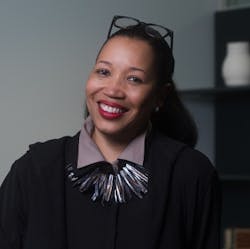Here’s Why the Design Industry Lacks Diversity and How it Will Change
Why? Because unless we as an industry ask difficult questions about racial and gender diversity and are intentional about fostering inclusion and inviting people to the table, we’ll keep having the same conversation wondering why nothing has changed.
Change is needed, to be sure: In an industry as universal and creative in nature as design, its persistent homogeny is illogical at best. Yet, statistics still demonstrate the industry is predominantly white, and males occupy most leadership positions in architecture and design firms. According to IIDA, for example, 69% of the 87,000 practitioners in the interior design industry are women, yet female leadership at design firms is only 25%. Additionally, only 36% of newly licensed architects are women and 2% are black.
Why the disparity? How did we get here? More importantly, how do we change the industry to ensure people of all races, genders and ages are represented at the table and their voices heard? interiors+sources recently spoke to a number of design professionals and academics to shed more light on the state of diversity in our industry and how we can pave a path toward progress.
What Does Diversity Mean?
As with any hot-button issues, semantics matter. Words like diversity, equity and inclusion get thrown around a lot, but what do we mean by them? If they remain merely buzzwords, they lose their potency, which is why diversity needs to be paired with action.
“I think of diversity as a plan, as a practice, as a policy,” notes Durst, Hon. FIIDA, LEED AP, executive vice president and CEO of IIDA. “It’s an outward manifestation of the consideration of race and gender and lifestyle and personality and education level—all of those things about human beings that we take into account when we’re talking about diversity.”
Likewise, in the context of design education, Jon Otis, IIDA, founder and principal of OlA - Object Agency, and professor of Interior Design at the Pratt Institute (pictured), explains that diversity “means seeing, hearing and working with people from different backgrounds, cultures, races and ethnicities. It’s an inclusive position.”
In other words, it isn’t a passive concept but, rather, an active one that questions why there is a lack of diversity in students from the U.S. enrolled in design schools, for example. “For me, something is missing and quite disturbing when I look out and see only white faces,” he says. “It’s not representative of the America I want to live and work in.”
Denise Rush, ASID, IIDA, dean of the School of Interior Architecture at The Boston Architectural College (BAC), (pictured) notes that diversity isn’t just about race, but also “variety and culture and experience. It’s like a tapestry of many different things.”
To take the tapestry analogy a step further, it’s an object of beauty that’s interwoven using numerous strands to form a bigger picture. It’s about bringing different elements together for a greater purpose. “The idea of equality and this idea of diversity is bringing not just genders and races and ages together, but actually collaborating together,” observes Jane Rohde, AIA, FIIDA, ASID, ACHA, CHID, LEED AP BD+C, principal and founder of JSR Associates Inc. Rohde says her firm is actively engaged in creating “a workshop environment” where collaboration can thrive and break down the traditional silos that still exist in different vertical design markets. Additionally, she points out that diversity isn’t just about sex or culture, but age as well.
All of these varied definitions are good (and accurate) because they fit into an even larger, interconnected framework built upon some our deepest human needs, as Dr. Mahesh Daas, Ph. D., DPACSA, ACSA distinguished professor, president of the BAC, explains.
[Related: Design Connections Day 1 Recap: Thoughts on Diversity]
“I would consider that diversity and inclusion are two complementary conditions of our world and life. Diversity, in my mind, acknowledges the infinitely rich, myriad and, I would say, distinctive manifestations of life. Inclusion, on the other hand, values and affirms the fundamental interconnectedness and universality of and the unity of all life,” he explains. “Inclusion and diversity actually emanate from empathy and humility. So, I think empathy, compassion and humility are essential if we want to cultivate conditions where diversity and inclusion can flourish.”
Behind the Status Quo
With this philosophical point of view in mind, it’s relatively easy to see how diversity can get left by the wayside. Drivers like access, competition and power structures aren’t driven by inclusion or humility. Instead, they foster an environment in which the “haves” may not deliberately operate against the interests of the “have nots,” but it doesn’t necessarily welcome them, either.
Daas (pictured) says there are a number of conditions that contribute to the lack of diversity, but to challenge it, a number of questions need to be raised, such as:
- Who has access to education?
- How much does it cost?
- Once an education is secured, what are the hoops one needs to jump through to get licensed?
- Then, once in the profession, is there equitable career advancement?
He adds that the institutions which educate, license and provide access to clientele have traditionally been set up for the privileged. “It’s no surprise, but there are safeguards that have been put in place that continue [to allow] the privileged to have access and the underprivileged not to have access. So, in that sense, it is institutionalized on many levels, and that’s something we have to be aware of constantly.”
Otis suggests the architecture and design industry “is still a man’s world at the top. A white man’s world actually,” citing architecture and business as the main drivers of this reality. Rush echoes the sentiment and says the industry looks much the same as it did 30 years ago, but with “a sprinkling of diversity. I don't know why this is, but it still is very homogenous. There are more women architects than there were, but it’s still a male-dominated field.”
Durst notes part of the reason there aren’t as many women in leadership today is because, traditionally, interiors have emerged within architecture firms which were predominantly founded by men. All agree, however, that times are changing.
“We’re seeing those numbers shift and change,” Durst observes. “There are more women enrolled in architecture school, and there have always been more women enrolled in interior design programs. But from a leadership standpoint, in the last five years, we’re starting to see that leadership formula shift and change so that there are now more women in studio director leadership positions.”
Otis predicts in the next couple of decades, women will be running the big firms and companies in the industry. “Women belong there. There is no rational reason why women shouldn’t be running companies and it makes no sense for any difference in pay scale,” he adds. “I find it hard to comprehend even how [such disparity] happens—who makes those small-minded and ignorant decisions, and let’s get those people out. Factors regarding this disparity are old-school and ignorant.”
There are other issues at play as well. Unlike other professions such as law, Durst suggests there has never been a clear-cut path to partnership in the design industry. As more women ascend to positions of leadership, she says formalized programs are being instituted, but that has not historically been the case.
Likewise, Rohde (pictured) says many female designers have not been taken seriously because they’ve often been labeled unfairly (as “decorators” for example) based on preconceived judgments rather than merit. “I was always lucky only because I was a registered architect, so I got a different level of respect in conversations,” Rohde recalls—a fact she says is “completely unfair” because often a designer knows more about materials than the architects, for example.
Compounding the issue is a perception problem of the profession among communities of color, Durst says, in which a commonly held belief is “a design career isn’t necessarily the right path for a person of color. It has been discouraged, and previous generations have [characterized design as] a ‘precious profession’ or a ‘luxury profession,’” she points out. “So, you have very traditional parents of color who were not encouraging their kids to pursue careers in design, and instead, to pursue the more traditional high-net-worth careers like law or medicine.” She says the same opinion exists in many immigrant communities where economic freedom is valued.
[Related: Celebrating the Legacy of Women in Design During Women’s History Month]
Rush explains that in underserved communities, many people aren’t aware of careers in the creative arts. They may know about fashion design, for instance, because of its conspicuousness, but the design of the built environment remains relatively invisible unless they are exposed to it early. “We definitely have to do outreach to high school and younger [students] because if you don’t see it, if you’re not told about it, you don’t know what the possibilities are.”
In other words, recruitment practices should be considered, especially in communities of color and other diverse groups.
Keys to Inclusion and Change
As Daas noted, diversity and inclusion are inextricably linked. One can’t exist without the other. Both must be sought in tandem if change is to occur, which is happening slowly but surely. But it requires intentionality industrywide.
“Inclusion is really the conversation that I think a lot of organizations are finally moving toward having,” Durst says. “It’s about culture and making everyone feel welcome. I’m glad that conversation has moved in the direction of inclusion,” she continues. “The end game I think is the equity that we’re all seeking and a level playing field for everyone.”
She adds that as with any other movement, change begins with awareness. It’s also about having conversations that may make people feel uncomfortable initially. But she says diversity and inclusion must be embraced by everyone, not a select few. “It’s not just a small group of people of color, or a small group of folks who want to move themselves forward. It takes embracing it by the larger community,” Durst suggests.
Rush agrees and says diversity “doesn’t just happen organically. You have to work at it. You have to have a plan. It has to be part of a firm’s culture or organization’s culture. If you don’t have that, then it's just not going to happen.”
[Related: Mary-Jean Eastman Helps Pave the Way for Women in Architecture]
As such, advocacy for academic initiatives and professional policies that foster more receptive and accepting environments for all designers is essential, according to Otis. Daas supports his assertion, saying “As a profession and as education institutions, we have to challenge [the status quo]. At the BAC, we have open access for that reason—that anybody who wants access to design education should be able to have access to it. We need to figure out how to make it possible for them and not exclude them because of what we cannot figure out,” he says.
In addition to early and fair access to education, Otis says it’s important to collaborate and partner with businesses; schools; professional organizations; and organizations that work with minority or at-risk students, students with disabilities or those part of the LBGTQ community. “Empowering people from a diversity of backgrounds to participate and contribute to the field will be an illuminating beneficial movement within design, supporting greater productivity and creativity in the profession.”
American Institute of Architects Puts Equity into Action
The American Institute of Architects (AIA) in 2015 ratified Resolution 15-1: Equity in Architecture, which was passed by member delegates at the National Convention, calling for “women and men to realize the goal of equitable practice in order to retain talent, advance the architecture profession and communicate the value of design in society.”
To that end, the AIA released several new chapters of its “Guidelines for Equitable Practice,” which includes a number of key ideas to help firms get started building equity in architecture and design.
These strategies serve as a reference to make connections between the more detailed information and recommendations outlined in each guide. Following are a few of the AIA’s strategies for putting equity into action at the firm level.
- Understand what best motivates you to improve equitable practices in architecture.
- Focus on self-awareness of your own cultural patterns and biases.
- Increase your capacity to acknowledge, value and work effectively with people who are different from you.
- Try shifting your perspective or frame to test out thinking about issues in new ways.
- Pay attention to common barriers in the profession that might apply to you, and learn how to avoid, navigate or reduce them.
- Learn what it takes to contribute to a positive workplace culture.
- Be an advocate for yourself and for others.
- Commit to the prevention of harassment and discrimination in the workplace.
- Know your rights and responsibilities as an individual and employer.
- Understand the dominant cultural patterns of your firm and whether they are hurting or helping your diversity, equity and inclusion goals.
- Develop and communicate equitable policies, protocols and practices.
- Invest in and train managers to develop knowledge and skills to support diverse employees.
- Question, audit and correct unfair practices.
- Make development opportunities available to all employees.
- Avoid making assumptions about what others are thinking, what they want or what their motivations are—ask and listen!
- Seek mentorship and sponsorship and provide them for everyone within, entering and interested in the profession.
- Actively reach out to other practitioners and groups to discuss diversity, equity and inclusion goals.
- Share stories, resources and knowledge.
Read Next: Where Are Design’s Women Leaders?
About the Author
Robert Nieminen
Market Content Director
Market Content Director, Architectural Products, BUILDINGS, and interiors+sources
Robert Nieminen is the Market Content Director of three leading B2B publications serving the commercial architecture and design industries: Architectural Products, BUILDINGS, and interiors+sources. With a career rooted in editorial excellence and a passion for storytelling, Robert oversees a diverse content portfolio that spans award-winning feature articles, strategic podcast programming, and digital media initiatives aimed at empowering design professionals, facility managers, and commercial building stakeholders.
He is the host of the I Hear Design podcast and curates the Smart Buildings Technology Report, bringing thought leadership to the forefront of innovation in built environments. Robert leads editorial and creative direction for multiple industry award programs—including the Elev8 Design Awards and Product Innovation Awards—and is a recognized voice in sustainability, smart technology integration, and forward-thinking design.
Known for his sharp editorial vision and data-informed strategies, Robert focuses on audience growth, engagement, and content monetization, leveraging AI tools and SEO-driven insights to future-proof B2B publishing.







